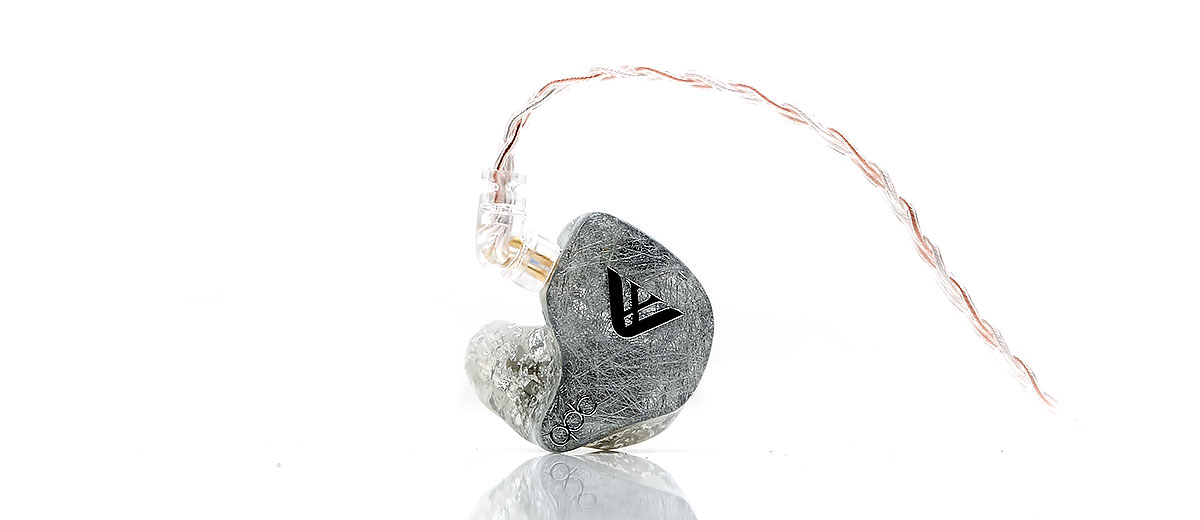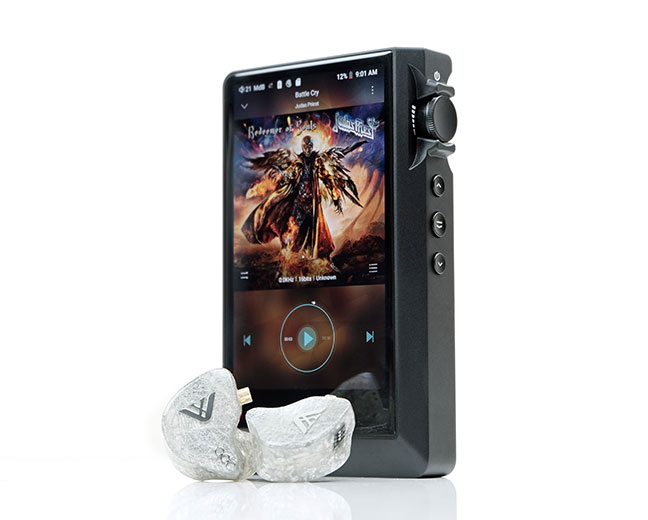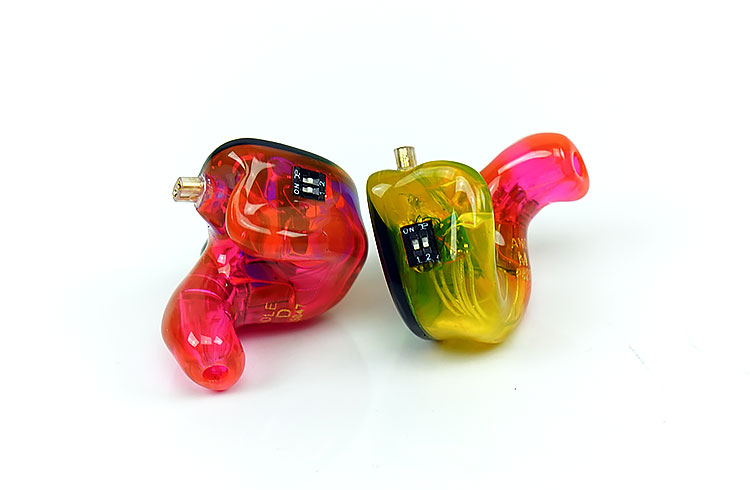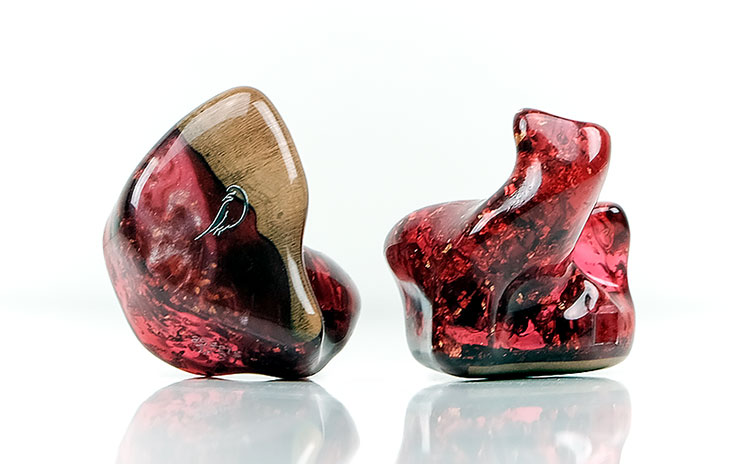Synergy
Efficiency
The qdc Anole VX has a variable rating of 15-19Ω and a sensitivity rating of 110-113dB SPL/mW which is a little more sensitive and easier to drive than the qdc Anole V6 we reviewed in January 2019. Much like the V6, we believe the parameters are set by the individual switch combinations which may affect volume, sensitivity, and output ratings but only marginally so.
Having compared to 2-3 reasonably sensitive monitors we would classify the Anole VX to be one of the more sensitive IEMs in the market today.
However, unlike the Vision Ears VE8 for example, the VX is a little better at suppressing background hiss on some DAPs with higher noise floors. We do believe that the higher SPL of the 122dB rated VE8 is a factor here and certainly, compared to the CA Solaris, the VX is not as sensitive to hiss.
Compared to the smaller V6, however, it is more sensitive to noise. On DAPs such as the Cayin n6ii and FiiO M11, hose balanced outputs can trigger a bit of hiss on sensitive IEMs, the VX picked it up a little easier than the V6.
How much? Not too bad overall, nothing distracting but not a black background. Using the Lotoo PAW Gold Touch did offer a black background with the VX and noise floors were very low indeed also on the Sony 1Z.
DSP
With today’s modern DAP DSP and PMEQ capabilities, I am finding timbral synergy to be much less of a studied work in progress than it used to be. You can mix and match and then tweak via EQ to your heart’s content to get the right synergy. And so it is the case with the VX with most of the flagships out there, especially with HiBy’s MSEB and iBasso and Lotoo’s excellent PMEQ systems.
The one area of the VX FR I like to target using the likes of the DX220, PAW Touch Gold PMEQ is that 4-6k range in stock format. You can pull it up by 3-4dB with a narrow band focus and you get some nice contrast and snap in the percussion timbre.
With HiBy’s MSEB on the Cayin N6ii, HiBy’s R6 and R5 you simply work a little more “crispness” in the Air section and maybe a little more coolness in the overall timbre to balance that out. That is a personal preference thing by the way.
Technical Capability
The rest is down to finding a DAP that can bring out the best level of dynamic range and detail with the VX’s brilliant performance as well as a low enough noise floor. I tended to go with the Lotoo Paw Gold for almost all listening sessions with the VX. The VX loves a clean source and the Sony 1Z paired with the VX, well, the treble never seemed tonally right for my tastes.
I got a bit more natural low-end girth with the Sony 1Z which I loved with the VX stock sound. However, with the VX bass switch, it is not totally necessary to pair with a weighty basshead DAP in the first place.
The switches will not dramatically alter resolution and dynamic range which I think is more important. The Lotoo was the absolute best for that with the DX220/AMP 1 a close second if the budget is a bit tighter.
Both also happen to have a lower noise floor than the Cayin N6ii and the HiBy R6 which I think is important for a monitor of this caliber to sound at its absolute best.
Select Comparisons
qdc Anole V6
$1320.00
Technical
The V6 is sort of a smaller sibling of the VX but pitches in roughly the same direction with a switch-type configuration in both universal and custom format. We reviewed the V6-C in January and I was blown away by the tone and timbre of its performance. Technically not quite up there in terms of resolution but in terms of “fun-factor” and musicality, it was just brilliant.
The V6 is also an all-BA build with 6 drivers instead of the VX’s 10 though both use a 3-way crossover. Both offer similarly high levels of build quality and both use horn nozzle designs for fine-tuning the presentation before it hits your ear canal.
The switch system does not have quite the same amount of options, 5 instead of 8 to be precise. The V6 options are all off, all on, strong bass, smooth vocal, and high sensitivity. I do not believe the VX has the same titles but they do target those 3 areas but with a few extra combos (6 in total) as well as all switches off and all on.
Performance
The Anole V6 is rated between 16-29Ω with an SPL range of 106-109dB SPL/mW. I had summarized before that the variation might be related to the switch design effect and the variations between each though qdc never really confirmed that.
The VX, by comparison, has a rating of 15-19Ω and a sensitivity rating of 110-113dB SPL/mW. That does suggest a slightly different range of balanced armature drivers as well as being somewhat easier to drive and a little more sensitive than the V6.
We tested both on 2 DAPs, the Lotoo PAW Gold Touch and the Sony 1Z. With both DAPs, either balanced or unbalanced low-gain, the V6 consistently needed a little more current than the VX. On the flip side, the VX is slightly more sensitive to noise floors and hiss compared to the V6.
With the PAW Gold Touch, both are dead quite balanced and unbalanced. Using the Sony 1Z, the performance is close but with the VX you can detect faint noise on the unbalanced output but only at really low volume levels. Paired with the Cayin N6ii, you get a more hiss on the balanced output similar to the FiiO M11 when paired with the VX compared to the quieter V6.
Tuning
My favorite for 2019 just got beaten and whilst their tuning is not a million miles apart, the VX does have a technical edge as well as some tonal differences that accentuate that.
Bass
In stock format, the most obvious is the low-end bass weight and the richness of detail it adds to the VX instrumental and vocal timbre. The Anole V6 bass, whilst warm and musical, doesn’t have the physicality of the VX low-end performance nor the weight so it doesn’t hit quite as hard.
The VX, on the technical side, delivers a bit more detail also so with that weightier instruments you get a lot more complexity in the texture of their note. The VX simply delivers a more spacious and more powerful low-end compared to the Anole V6.
If you are partial to the Anole V6 lighter bass then you could argue that the bass up on the VX might be too strong for audiophile sensibilities but otherwise expect a far more powerful low-end response from the VX than what the bass switch on the V6 can offer. This is in terms of both weight, warmth, and staging depth.
Vocals
Vocals will seem a little further forward with more presence on the Anole V6 but in actual fact, it is more to do with slightly less weight on the low-end allowing that to happen. The VX is just as forward but the great low-end depth and power take a greater share of the listener’s attention. They are also a little denser and richer sounding than the V6’s slightly lighter tone.
With the mids up switch, the balance between the two remains relatively unchanged. The V6 seems further forward and the more intimate of the two with vocals very much front and center. The VX pushes the vocal forward also but it is not as forward by comparison and a toucher smoother also with a little more low-end weight and warmth creeping into the timbre.
Treble
I actually think the treble on the V6 is marginally peppier, especially in the lower-treble and percussion timbre. However, the VX delivers a little more refinement and detail and also a bit more body. The V6 is a lighter treble tone, perhaps a shade leaner with all switches off.
I find that pushing up both the mids and treble switch gives me a far more articulate and energetic treble performance that surpasses the treble switch activation of the Anole V6. It is not enough to push up the treble alone on the VX because I think that 4-6k dip in the VX needs a bit of correction for a smoother mids to treble transition.
Vision Ears VE8
€2900
Technical
The VE8 is the penultimate monitor in the Vision Ears range having been taken over recently by the hybrid Elysium. Like the VX-C, the VE8 is an all-BA custom monitor with a 3-way crossover but sporting 8 drivers as opposed to 10 inside the VX-C.
Both offer unique design potential and fittings are excellent. However, side by side, the VE8 is the smaller of the two monitors and sits a little more flush to the ear than the VX-C. Both monitors deploy a horn design, however, the VE8’s are a little deeper and wider. Quite what difference that might make I am not entirely sure.
The VE8 also uses a regular 2-pin socket whereas qdc deploy their protruding reversed polarity sockets making the VX-C much harder for cable rolling.
Performance
The VE8 is rated at 22Ω and 122dB SPL compared to the variable 15-19Ω and 110-113dB SPL/mW of the VX-C. Both are very easy to drive and should not require any specific high amplification stages. Moderate DAPs and good quality smartphones should drive them sufficiently.
I was expecting the VE8 to be the more sensitive of the two with that higher SPL rating and true enough our testing with both the Sony 1Z and the Lotoo PAW Gold Touch showed up a small gap in volume though not huge, maybe 1-2 steps max. On low volume on the FiiO M11 and Cayin N6ii, the VE8 also displayed a higher level of background noise or hiss than the VX-C.
Tuning
Bass
I was expecting the VE8 to be much heavier on the low-end but the gap was not huge with the switches off on the VX. Certainly, the VE8 is punchier on the low-end, has a snap to it compared to the slightly softer and perhaps warmer mid-bass and more neutral sub-bass signature of the VX. Not that the VX is lacking with switches off, just not as planted or impactful.
Turning the bass switch up on the VX changes things completely. The punch factor on the VE8 is still there but the weight, body, and sub-bass presence is much more substantial on the VX. I dare say even bassheads who shy away from BA timbre might enjoy the quantity on the VX at the very least.
Mids
The next key difference is the upper mids of the VX compared to the VE8. That significant 4-6k dip on the stock VX tuning is not there on the VE8. It remains fairly sustained and elevated into the treble.
As a result, the VE8 mids have a bit more odd-harmonics in its tonal balance sounding relatively clean and clear, whereas the VX sounds richer, more full-blooded, and smoother. Percussion also has a bit more bite and prominence on the VE8 whereas the VX adds body but comes across as a little softer.
One very important thing to note is that aside from the harmonic balance and slightly richer texture of the Vx, the VE8 vocal positioning is a little further back in the mix when the low-end gets busy. The VX retains a little more forwardness, especially for male vocals with all switches off.
On a personal preference level, I prefer both the mids and treble switch on with the VX for vocals. I like the VE8 upper mids clarity and peppier lower treble compared to the stock VX tuning. You can change that plus obtain more vocal presence than the VE8 with the mids and treble switch up on the VX.
Treble
The VE8 treble has a bit more peppiness than the VX with switches off. That lack of dip in the 4-6k range plus a little more elevation closer to 10k compared to the VX will deliver a bit more treble contrast and energy.
You will hear that in the VE8 percussion that trades weight for more bite and vocals that can show a little more natural sibilance in recodings. The VX is the more euphonic of the two with a slightly subdued percussion ‘splash’ by comparison.
With the treble switch up the VX is a bit cleaner with more treble presence but it is not a huge switch up and I find I need to turn on the mids switch also to combat that slight 4-6k dip completely. It is a transitional thing but with both switches on the VX top-end is cleaner with more bite and upper mids percussion presence.
Lark Studio LSXC
$1699
Technical
The Lark Studio LSXC is the company’s current flagship custom monitor and like the VX you can get it in either universal (LSX) or custom format (LSXC).
Also, like the VX-C the LSXC is an all-BA 10 driver 4-way crossover design but the price difference is substantial with the Lark coming in at almost $1000 less. That will tempt quite a few high rollers to be perfectly honest if the sound signature suits.
The craftsmanship on the LSXC is very good actually with some lovely blends of colors and horn principle nozzle finishes. Like the VE8 it is a bit smaller than the VX-C. I suspect the enhanced girth of the VX-C in comparison to these two alternatives is more down to giving that switch box a bit of space to breathe.
I would give the qdc design choices a slight edge over the LSXC but it is early days in the life of Lark Studio so the jury is out for now on this point. Worth pointing out, however, that the Lark Studio design choices are free of charge or no additional fees which are hugely welcome. qdc fees are some of the highest I have ever seen.
I would also give qdc a little edge on the fitting but this is more anecdotal than factual given ear impressions can vary in quality and often the manufacturer can only work with what they have got in front of them.
Performance
The LXSC is rated at 20Ω and 110DB SPL and reasonably close on paper to the 15-19dB and 110-113dB SPL of the VX-C.
However, in real-world testing, the VX-C is easier to drive and requires a little less current or volume than the LSXC to volume match properly. There is a slight dynamic range issue with the LSXC performance that might add to the perception that the VX-C is easier to drive.
On the flip side, the Lark Studio LSXC is less sensitive to higher noise floors and hiss in some analog amp stages. With our slightly noisier DAPs, the M11 and N6ii, the VX-C picked up hiss a little easier than the LSXC.
Tuning
We used the LSXC with the PWAudio Saladin cable option which you can avail of in their Splendor package for an additional fee. The stock cable is simply too warm and muddy sounding with the LSXC whereas the Saladin enhances separation and produces a more neutral performance.
With switches off the LSXC is warmer, more intimate, and richer sounding in the bass and lower-mids and very relaxed in the treble. The VX is more linear, more balanced sounding with less low-end/lower-mids warmth and a more neutral vocal positioning.
Bass
The VX bass can vary significantly with the bass switches. With the bass switch off the LSXC delivers more body warmth and weight. However, with the VX bass switch on, you get a stronger bass response compared to the LSXC and a slightly deeper cut into the lower-mids also.
The LSXC doesn’t cut as deep and carries a bit more warmth further up into the lower mids. As a result, perceived instrumental positioning is further back on the VX, less intimate. The stronger low-end of the bass switch will contribute to a perception of more depth and a wider, more holographic soundstage.
Mids
Mids are more open on the VX, with better staging width and instrumental separation. Female vocals on the LSXC are closer, more intimate, and “bigger sounding” on LSXC. The LSXC may be more forward in the mids but it lacks air with a fairly strong 3-5k dip. The VX dips from 5-6k to get that wetter less “spikey” treble tone so vocals are less affected.
Switching the mids switch on will give the VX a significant advantage for male vocals. Here, it sounds clean, clear, and yet still very natural and accurate with plenty of detail. On the LSXC it sounds a little close, compressed with a slight veil and not as much detail shining through.
Treble
Both monitors are reasonably relaxed and not overcooked or overly bright in their treble delivery. The key FR difference is the natural peak of the LSXC which occurs around 5-6k compared to the VX which dips at the same point with a peak closer to 7-8k. This is with switches off.
On a technical level, the peak of the LSXC comes a little too soon and the timbre can sound a little too rounded and even-harmonic biased with not enough air and separation. The VX extends better for me with more headroom and a timbre that still errs to the smooth side but is more realistic sounding.
With the treble switch on the VX gets a little cleaner, with a bit more treble articulation and energy. It is not the kind of change-up that delivers “bright and peaky, however. Just a touch more emphasis and an airy more expensive top-end compared to the LSXC.
You can emphasize the energy and focus of the VX even more with the mids and treble switched turned on. It will obliterate the LSXC in the mids and treble for detail, vocal clarity, and spaciousness. However, the bass may be quite neutral for some compared to the body of the LSXC.
Our Verdict
The Anole V6 was a complete and very welcome surprise to me at the start of the year. Whilst the Anole VX builds on the V6 profile and thus somewhat less of a surprise it does surpass it in many ways making this a top-tier world-class monitor.
There is nothing dry or sterile about the VX tuning. It takes that musical, slightly euphonic, and vocal-centric tuning of the V6 and adds low-end power, mids richness, and much more detail throughout.
Do you want even more power? Throw on the bass switch. Do you want more mids and treble clarity? Throw on both of those switches which is where I think it sounds at its absolute best.
There are now more tuning choices, a slightly more mature sound, and bags more detail all wrapped in qdc’s usual immaculately designed and very comfortable custom builds. It is going to be right up there as a potential contender for 2019 no doubt and whilst I still have a special place for the V6 I can’t deny just how brilliant the VX sounds. Over to you!
qdc Anole VX Specifications
- Sensitivity : 110-113dB SPL/mW
- Frequency response :10Hz-20000Hz
- Impedance:15-19Ω
- Armature units: 10 micro balanced armature
- Noise isolation: 26dB
- Monitor plug: 3.5mm(1/8″) connector
- Cable: optional
- Technical feature:3 sound channels, 3-way crossover, natural restoring, superb music quality
- Frequency response types: 8 Types
- Classification: Standard VX-S
- Recommend: monitor and music enthusiast






